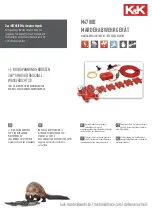
MX31 Cab, MX31FU Radio Cab Page 5
s
Hole for hook or nail Loop attachement
Cooling slots
DAYLIGHT SENSOR
Automatically adapts the display illumination and LED indicators
to the available light.
POWER SUPPLY SOCKET (MX31FU
/
MX31ZL only)
For charging the battery with an external charger, as an alterna-
tive to charging the cab through the CAN bus. Can also be used
for “back-up power” (when battery is empty), connected to the
track for example.
DISPLAY
Relevant information is displayed in various graphic renditions
depending on the operating mode selected. The display of the
“OPERATOR” mode is “cleaned-up”, while the “EXPERT” mode
shows as much information as possible.
The basic display pattern is:
- Active mode shown in top black bar (LOCO, SWI, PROG...),
clock;
- Current object displayed in large font (address, names etc.);
- EXPERT mode: center black bar displays feedback information
(radio, “bidirectional communication”);
- EXPERT mode: two display areas. Lower display half is used
for applications like previewing recall memory, operating a sec-
ond engine or displaying function icons.
GREEN background – LOCO MODE
RED background – SWITCH MODE
YELLOW background – INPUT MODE: Address, menu, list of
names, programming and more.
SOFTKEYS M I II III
Soft keys have different meanings depending on operating mode
and state and will be made visible in the display:
- The M key activates in most cases a menu - depending on the
level either status related, system related or cab related.
- I, II, III switches between operating mode (GUEST, EXPERT
etc.), selects the kind of information displayed in the lower dis-
play (recall memory, second address, pictogram etc.).
UPPER KEYPAD F U T P . . .
F, W: Activates entered address, also serves as scroll key (in-
stead of scroll wheel); starts programming procedure (operations
mode) when used together with E key.
U: “Stealing” address from other cabs; rotates through consist.
T: Consist activation/deactivation (Incl. Turnout ladders), proto-
col selection
C: “Cancel” key; when programming: CV selection
MN and RG keys with associated LED’s
MN
(= MAN): Overrides signal controlled speed influence
(„asymmetrical DCC-Signals” as well); key E-MN pressed to-
gether starts service mode programming.
RG
: Half speed key and/or shunting functions.
SHIFT KEY
: Shifts to capital letters, functions F10 and up
(together with number key), emergency stop (together with stop
key) and more.
ANTENNA TERMINAL (MX31FU only)
Accepts antenna supplied with cab.
2 CAN BUS SOCKETS
Connect to command station and additional cabs.
6-LED LIGHTBAR
- Light moves up or down to indicate the direction the slider has
to be moved to “catch” the actual speed of a newly acquired en-
gine and during a stop or emergency stop.
- Display of “signal controlled speed limits” sent back by the de-
coder (bidirectional communication) and more.
SCROLL WHEEL
Scroll and select data from recall memory, name tables, menus;
also used to control a second engine, analog functions and
sound parameters in sound decoders.
SLIDER
Controls speed of current engine or consist when in DRIVING
mode (LOCO), but also in ACCESSORY (SWI) or other modes
for the last activated engine address.
DIRECTION KEY WITH LED’s and STOP KEY
R: Direction key can also be used, like the slider, outside the
DRIVING mode. Direction indicated in relation to engine
(Fwd/Rev) or layout (East/West; taken from bidirectional
communications data).
S:
Stop key for single address (press once); Emergency stop
(press several times!), turns track power off (after emergency
stop) and turns track power back on after short circuit.
“A” KEY
Activates addresses in table display or deactivates current ad-
dress (in EXPERT mode press
-A
)
;
common “ENTER”
or
“ACCEPT”
key during programming and other procedures;
“YES”
key; “ON” switch for radio cab, when operated in radio
mode.
“E” KEY
Initiates programming procedures or “E” procedures (when im-
mediately followed by or pressed together with another key);
common “END”
or
“ESCAPE” key
to end programming, “E”
procedures, menu etc.;
“NO”
key as opposed to “A” key; Turns
off radio cab when pressed together with “A” key.
NUMBER KEYS with LED’s above
Depending on operating mode: Input of addresses, names, all
numerical values (during programming, definition); Actuate func-
tions (F0, F1 etc), accessories, turnout ladders, AOS’ and so
on; LED’s show state of function, AOS activation etc.
Содержание MX31FU
Страница 6: ...Page 6 MX31 Cab MX31FU Radio Cab 4 QUICK GUIDE...
Страница 7: ...MX31 Cab MX31FU Radio Cab Page 7...
Страница 29: ...MX31 Cab MX31FU Radio Cab Page 29...





































